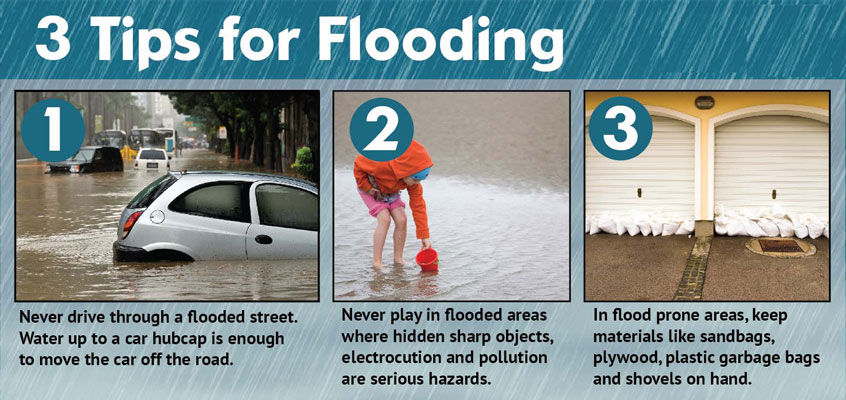What Is Flooding?
Flooding is the most common natural disaster in the country. Floods can happen anywhere. Different parts of the same neighborhood can be prone to flooding for different reasons.

Flood Insurance
Everyone is at risk of flooding. By choosing to purchase flood insurance, you cannot lose. In fact, floods are often caused by storms, hurricanes and water backup due to inadequate or overloaded drainage systems. Most homeowners' insurance does not cover costly flood damage. The National Flood Insurance Program (NFIP) is your primary source for flood insurance in the U.S. Talk to your insurance agent if you have questions, would like additional information, and or are ready to purchase a flood insurance policy.
Flood insurance is available to everyone, regardless of whether you rent, own, or have a business and is available even if you are not in a mapped flood plain. Flood insurance is not included in your property insurance policy.
For more information, visit www.fema.gov/national-flood-insurance-program.
FEMA Flood Map Service Center
The FEMA Flood Map Service Center (MSC) is the official public source for flood hazard information produced in support of the National Flood Insurance Program (NFIP). Use the MSC to find your official flood map, access a range of other flood hazard products and take advantage of tools for better understanding flood risks.
Keep In Mind
This is Severe Weather Awareness Week and while Florida residents are familiar with tropical storms and hurricanes, it does not take a named storm to cause flooding.
Florida is vulnerable to flooding at any time of the year. Mostly surrounded by water, the abundant supply of moisture feeds the development of thunderstorms, which may produce heavy rains during a short period of time. When those heavy rains occur, the ground may not be able to absorb all of the rainwater and flooding may occur. Due to the flat ground in portions of the state, floodwater may sometimes remain in an area for days, weeks, or even months.
Not all floods are alike. Some floods develop slowly, taking anywhere from a few hours to a few days to have an impact. On the other hand, flash floods happen quickly, sometimes in a
matter of minutes.
Most flooding-related deaths in the United States are due to people driving their cars into flooded areas. Moving water only as deep as a car’s hubcaps can be enough to move the car off the road; and it may only take 12 to 16 inches of water to cause a car to float. Driving on flooded roads is also dangerous because the road may be washed out, or there are unseen
dangers in the water that could cause damage to your vehicle and threaten your life. When you encounter a flooded roadway, it is important to remember, “Turn around. Don’t drown!”
Florida has more than 2,200 miles of tidal shoreline. Because of this, many areas of Florida are also prone to coastal flooding. This may come from storm surge associated with tropical storms or from other causes such as strong on-shore winds or higher than normal tides due to lunar effects.
Meteorologists at the National Hurricane Center and local Florida National Weather Service watch thunderstorms and tropical systems closely to forecast how much rainfall it may produce and how much flooding may occur. The National Weather Service will issue coastal flood advisories, watches and warnings similar to inland flood statements. District staff closely monitor water bodies and adjust flood control structures when appropriate.